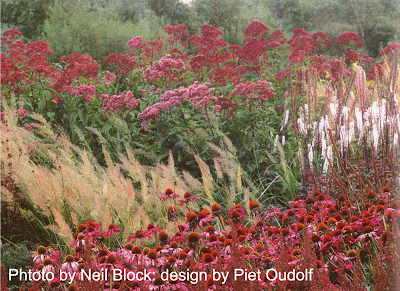Friday, March 7, 2014
Native Plant Myth 3 Native Plants are not as showy or ornamental as exotic plants
I am dedicating the last of my series on “Myths about Native Plants” to a subtle but widely held misconception. I believe that this particular misconception is the number one reason that prevents people from embracing natives more fully in designed landscapes.
Myth 3: Native plants are not as showy or ornamental as exotic plants.
It’s not that people think that native plants are ugly; rather, when it comes to choosing plants, natives are perceived to be a bit more natural, less over-the-top-bloomy than exotic garden plants. Walk into your local garden center and just try to resist the seduction of a lipstick-red Knockout Rose or the voluptuous softball-sized flowers of a Limelight Hydrangea. The native section, by comparison, is populated by a sad collection of leggy, dull perennials.
 |
| Dogtooth Violet |
When I was in graduate school, I took my girlfriend to the local botanical garden. I had just finished a class on native plants, and I wanted to show her how wonderful and unappreciated our local plants were. When we arrived, the native garden was hard to distinguish from the unmanaged woodland next to it, and the only plant blooming was a Dogtooth Violet. I got on my knees to show her how delicate and beautiful this little plant was. It was so exquisite it barely existed. She seemed unimpressed. On our way out of the garden, we passed a tulip border that was so colorful, so showy, I was convinced one could see it from the moon. She exclaimed, “Now that’s beautiful!” I knew then my cause was lost.
Since then, I have designed plantings for scores of gardens and public landscapes, particularly large scale perennial plantings. I use native plants interchangeably with exotics for incredibly showy borders and beds. The palette of native plants I use is large and knock-your-socks-off bloomy. Turn-your-head saturated with color. Va-va voom impact. In fact, natives from the American prairie are incredibly popular right now in European designed gardens. The problem is not that native plants are intrinsically less ornamental than exotics; the problem is one of design. Native gardens, for the most part, overly imitate natural plant communities. Native gardens end up looking like some poor imitation of a woodland or meadow. As a result, we have no precedent for natives in man-made landscapes.
 |
| A border of mostly American natives designed by Piet Oudolf; photo by Neil Block |
Listen up native plant advocates: until native plants are shown to be beautiful, they will never be fully embraced by the American public. The argument about habitat and the environment are good, but what people ultimately want in their landscapes is something pretty. What we are missing are native plant gardens dedicated to showing the ornamental beauty of native plants. Each time a new native garden imitates a natural habitat, we reinforce the notion that native plants aren’t worthy in the designed landscapes.
This is exactly why the New Native Plant Garden at The New York Botanical Garden excites me so much. The 3.5-acre garden currently under construction will showcase “the beauty and diversity of native plants and the best in contemporary garden design.” Vice President Todd Forrest created much of the vision for the garden as a “departure from the habitat-based model that has shaped the design of many public native plant gardens.” Instead, the garden will be “foremost a beautiful garden with native plants providing both seasonal spectacle and year-round structure.” NYBG has charged Oehme, van Sweden and Associates (OvS) to design the gardens. Principal Sheila Brady, project manager Hilary Oat-Judge, and others at OvS are creating a series of garden rooms to work with the site’s diverse topography, hydrology, and habitats.
The previous garden, according to Forrest, featured a series of regional ecosystems such as the New Jersey Pine Barrens, Long Island’s Hempstead Plains, and a serpentine barren. But these ecosystems became impossible to maintain at such a small scale. Forrest says, “Aggressive generalists overran their more demure counterparts, and the various habitats quickly lost their character.” What’s worse, says Forrest, is that “the garden seemed designed to preach to the choir and ignore the congregation. Native plant enthusiasts noted the presence of their favorite taxa, while the general public was left wondering exactly where the ‘garden’ was.”
The focus of the new garden is on the quality of the design, not on imitating a habitat. I had the pleasure of working on the early stages of this project at OvS. I can say with confidence: the designs for this space are outstanding. The design will, in Forrest’s words, “redefine what a native plant garden can be.” The garden will feature bold, contemporary geometry of boardwalks, bio-filtering water features, and modern plantings. The garden is slated to open in 2012. Here is a link with more information about the garden.
What is so exciting about this new garden is that it sheds the nostalgia of other native plant gardens that look backwards to some declining ecosystem. This garden looks to the future. It will be a model that shows that native plants can populate and beautify the places that need them the most: our front yards, public parks, and corporate landscapes.
Subscribe to:
Post Comments (Atom)

No comments:
Post a Comment